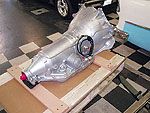
When I drive a car, any car, I like things relatively quiet. I like to go straight. I like to stop within reason. I especially like it when the engine responds to the throttle appropriately. This is nothing beyond the reason of a typical driver. Now, with older cars, I particularly like to cruise on the highway without revving rpms to the extent that the stereo is drowned out (granted there is a stereo to begin with!) with excessive exhaust notes. With most early drivetrains, well, that's pretty impossible. Even with some of your modern 350/350 transplants, the rearend gearing is so low that the situation is nearly the same as with the stock setup! Sure, swapping out the ring-and-pinion for a taller set will give you a bit more highway elbow room, but you'll sacrifice low end in doing so (how much is all dependent on how big a jump you take in gearing). For those who like the way their car performs around town but would really like to keep up with the flow of traffic on the freeway without sounding like you're going to spin a main bearing, there is a solution, and it's not the option many of you are thinking of.
The alternative to the overdrive standard, the 700-R4, is its smaller cousin, the 200-4R. GM's "other" overdrive, albeit somewhat overlooked, can offer you and your ride all the benefits of low-revving highway cruising without having to sacrifice quite as much room to fit. Now, don't automatically assume that due to its nomenclature being smaller that it's a lightweight. While in (most) original forms, the 200 is smaller and was used in lighter-duty applications, when prepared in the right manner, it can handle the horses (in upwards of 500) with all the brute force you need. Actually, according to Phoenix Transmissions, the 200 is more forgiving, which means it can take more punishment and heat! Plus, instead of the typical 30 percent overdrive you get with the bigger trans, the 200 offers a whopping 33 percent. With that, though, you get a taller 1-2 gear set, which is due to the fact that the vehicles the transmission were designed for had higher-ratio rearends, thus needing more help off the line. Look at it this way: With a typical 3.23:1 rear, your final 1:1 ratio at 65 mph with a 27 1/2-inch tire will put you in the 2,500-rpm range. Not too bad, but there's definitely room to rev. Throw things into Fourth (overdrive), and you're down in the 1,600 rpm range--nearly a 1,000-rpm drop (3.54s will put you right around 1,800 rpm; 3.73s right at 2,000). The safe way to factor in your rpm drop with your current rearend is to simply subtract 1,000 (fully locked up, otherwise it's around 800--see below for more on lockup). Keep in mind that your tire sizing does play an important factor, as well.
With all the benefits, there is a downside to GM overdrive transmissions, one that cannot be ignored. You absolutely, without question, have to keep the TV cable properly set up and adjusted. Not doing so can ultimately lead to the demise of your tranny...in short order! Keeping your TV in tune is not a difficult task, but because maladjustment can so easily ruin the unit, it's the main reason so many shy away from overdrives. Phoenix provides its customers will all-new, factory-style TV cables, but it is up to the end user to come up with the proper bracketry. While you have a number of options (including some nice stuff from Holley), it's important that you get the right setup for your particular carburetor. For our situation, that lead us to BowTie Overdrive's advanced TV cable system, which not only sets the cable in the right position, but it's cam-like throttle linkage adapter ensures you have proper cable tension and pressure at all positions.
The last area of concern with the GM overdrives is just as important as the TV cable: the lockup feature. This feature electronically puts the converter into lockup mode in Fourth gear, which is great for open-road higher-mileage cruising, but can be troublesome at the 3-4 shift point for many. Because of this, many choose to run the transmissions with the lockup control unplugged, or better yet, purchase a non-lockup version to alleviate the situation altogether. Our 200-4R from Phoenix came with the electronic lockup option, which we gladly used. Speaking of which, let's get into the actual installation, shall we.When I say we, I'm referring to Primedia's new Tech Center manager, Jason--whom you all might recognize from other previous installation stories--and myself.
Jason was presented with the chore of installing the new Phoenix 200 into my '53 Chevy, which was previously shifted with a standard (short tailshaft) Turbo 350. Which leads to one of the other great things about the 200--it's the same length as the short TH350 (the tail mount being the only "geographical" difference). This meant no driveshaft shortening was necessary, only the fabrication of a new rear trans crossmember. Even the cooler lines routed in the same location, so the work involved with the swap was very minimal. Our main objectives were to get the TV system hooked up correctly, and take our Lokar 700-R4 shifter and make it work on the 200. (Yes, Lokar makes a specific shifter for the 200...we got the wrong one!)
Whether you're currently running a late-model (three-speed) automatic or an early manual, if you want to take the leap to the world of overdrives, there are people out there willing to help make sure you do it properly--including us! If you like to really drive your car, this is definitely the way to go.